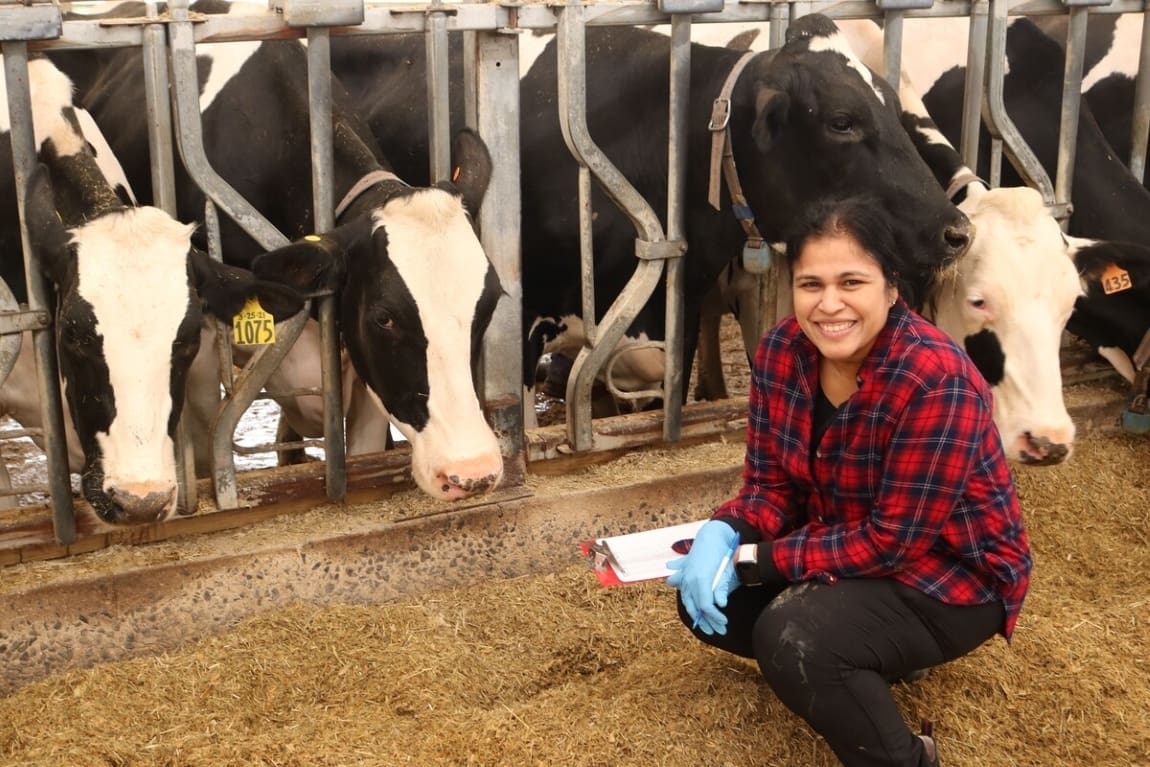New research from the University of Pennsylvania School of Veterinary Medicine has implications for addressing a leading contributor to climate warming.
By Erica Moser | University of Pennsylvania
Methane is the second-largest contributor to climate warming after carbon dioxide, and so scientists have put a lot of attention toward addressing one of the top sources: methane emissions from livestock. In other words, cow burps are bad for the planet.
Farmers add various seaweeds to cow diets as a source of protein, unsaturated fats, and other health-promoting ingredients that provide immediate energy, says Dipti Pitta of the University of Pennsylvania School of Veterinary Medicine, and a 2016 study in Australia found that feeding sheep a species of red seaweed called Asparagopsis taxiformis (AT) eliminated methane emissions by 80%.
But the effects of this seaweed vary widely, and so researchers from Pitta’s Agricultural Systems and Microbial Genomics Laboratory (ASMG lab) and Pennsylvania State University undertook an assessment of how it alters the microbiome in the rumen, a compartment of a cow’s stomach.
The results are published in the journal mBio.
The researchers randomly split 20 cows between four treatments: a high dose of AT; a low dose of this red seaweed; oregano, which also inhibits methane formation; and the control group. They rotated the animals among the treatments in four 28-day periods. The team found that the high dose of the seaweed inhibited methane emissions by 55% in the first two periods, but the effect appears short-lived. It gradually declined by the third and fourth periods.
Pitta says this is one of the first studies examining how methane is formed in the rumen and how methane pathways are altered under various mitigation strategies, noting the importance of preserving microbiome health and animal productivity when addressing methane reduction. Past research has not looked at the effects of AT on microbial populations and their functional pathways in this level of detail.
The researchers found that in the first two 28-day periods, the high dose of seaweed led to a near total elimination of Methanosphaera, a microbe that uses hydrogen to reduce methanol to methane, in the rumen. Pitta says that this is important because the seaweed treatment didn’t have the same effect on other microbes that produce methane, leading researchers to believe that Methanosphaera plays a larger role in methane formation than previously thought.
However, the study explains that Methanosphaera populations spiked in later periods because they were unable to inactivate bromoform, a substance in seaweeds that suppresses the formation of methane in the rumen.
The study also explored the activity of enzymes involved in methanogenesis, the process of producing methane as a byproduct of energy metabolism. First author Nagaraju Indugu, a senior research investigator in the ASMG lab, says the enzymes involved in this pathway were reduced, compared to the control group, when the cows were given AT.
The authors also note that, while they expected indirect effects of AT on bacteria in the microbiota, they also found direct effects that were less expected. Specifically, types of bacteria that produce butyrate, a short-chain fatty acid serving as an energy source for cows, were significantly increased in seaweed-treated animals compared to the control group.
“It’s very important to understand what the nutrient content of seaweed is and what the antimicrobial effects of seaweeds are so that we better understand the impact of the overall inclusion of different concentrations of seaweeds to the animal diet,” Pitta says.
Indugu says the past work of the ASMG lab led to the current study. Researchers previously reported that the organic compound 3-Nitrooxypropanol reduced methane emissions by 26%, and a subsequent study determined the microbial characteristics of low-methane-emitting cows.
Looking ahead, Pitta says the lab is working on combining different strategies, such as testing seaweed in the diets of cows that have been identified as high methane emitters or low methane emitters. “Combining those with the seaweeds might give us an opportunity to effectively reduce methane by a much higher magnitude than when you do any one strategy alone,” she says.
Pitta adds that researchers are also investigating different doses of seaweed varieties in methanogenic cultures, which will provide more specificity on the concentrations necessary to inhibit methanogenesis.
***
Dipti Pitta is the Mark Whittier and Lila Griswold Allam Associate Professor of Ruminant Nutrition at the University of Pennsylvania School of Veterinary Medicine.
Nagaraju Indugu is a senior investigator in bioinformatics in the Agricultural Systems and Microbial Genomics Laboratory at Penn Vet.
The other co-authors are Joseph S. Bender, Grace Dai, Satvik Garapati, Meagan L. Hennessy, Kapil Narayan, Reeti Shah, and Bonnie Vecchiarelli of Penn Vet; Camila Lage, Audino Melgar, and Alexander N. Hristov, Susanna E. Räisänen, Hannah A. Stefenoni, Sergio A. Welchez, and Derek Wasson of Penn State University; and Charles Yarish of the University of Connecticut.
This research was supported by the U.S. Department of Agriculture National Institute of Food and Agriculture Federal Appropriations (PEN 04538, 1000803, and 2017-05832).
More information: Indugu N, Narayan K, Stefenoni HA, Hennessy ML, Vecchiarelli B, Bender JS, Shah R, Dai G, Garapati S, Yarish C, Welchez SC, Räisänen SE, Wasson D, Lage C, Melgar A, Hristov AN, Pitta DW. ‘Microbiome-informed study of the mechanistic basis of methane inhibition by Asparagopsis taxiformis in dairy cattle’, mBio (0:e00782; 2024); DOI: 10.1128/mbio.00782-24 | UP Press Release/Material. Featured image credit: Courtesy of Dipti Pitta




